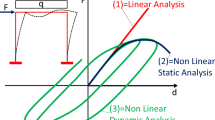Abstract
This paper presents a simplified method of evaluating the seismic performance of buildings. The proposed method is based on the transformation of a multiple degree of freedom (MDOF) system to an equivalent single degree of freedom (SDOF) system using a simple and intuitive process. The proposed method is intended for evaluating the seismic performance of the buildings at the intermediate stages in design, while a rigorous method would be applied to the final design. The performance of the method is evaluated using a series of buildings which are assumed to be located in Victoria in western Canada, and designed based on the upcoming version of the National Building Code of Canada which is due to be published in 2005. To resist lateral loads, some of these buildings contain reinforced concrete moment resisting frames, while others contain reinforced concrete shear walls. Each building model has been subjected to a set of site-specific seismic spectrum compatible ground motion records, and the response has been determined using the proposed method and the general method for MDOF systems. The results from the study indicate that the proposed method can serve as a useful tool for evaluation of seismic performance of buildings, and carrying out performance based design.
Similar content being viewed by others
References
Adams J, Weichert D, Halchuk S and Basham P (1999), “Seismic Hazard Maps of Canada,”Geological Survey of Canada, Open File 3724.
Atkinson GM and Beresnev IA (1998), “Compatible Ground Motion Time-histories for New National Hazard Maps,”Canadian Journal of Civil Engineering,25: 305–318.
Bagchi A (1999), “Seismic Performance of Buildings Designed to National Building Code of Canada,”8th Canadian Conference on Earthquake Engineering, Vancouver, B.C., Canada, pp.487–494.
Bagchi A (2001), “Evaluation of the Seismic Performance of Reinforced Concrete Buildings,”Ph.D. Thesis, Department of Civil and Environmental Engineering, Carleton University, Ottawa, Ontario, Canada.
Building Seismic Safety Council (BSSC) (1997), “Recommended Provisions for Seismic Regulations for New Buildings and Commentary,”National Earthquake Hazards Reduction Program (NEHRP), Federal Emergency Management Agency, Washington, D.C.
Chopra A and Goel R (2001), “A Modal Pushover Analysis Procedure to Estimate Seismic Demands for Buildings: Theory and Preliminary Evaluation”,PEER Report #2001/03, Pacific Earthquake Engineering Research Centre, Berkeley, USA.
Fajfar P and Gaspersic P (1996), “The N2 Method for the Seismic Damage Analysis of RC Buildings,”Earthquake Engineering and Structural Dynamics,25: 31–46.
Ghobarah A, Aly NM, and El-Attar M (1997), “Performance Level Criteria Evaluation,”Seismic Design Methodologies for the Next Generation of Codes, edited by Fajfar and Krawinkler, pp.207–215.
Humar JL (2000), “Future Directions of Seismic Design Provisions,”Short Course on Earthquake Resistant Design of Buildings, Carleton University, Ottawa, Canada.
Humar JL and Bagchi A (2000), “Seismic Level of Protection in Shear Wall Frame Structures Designed According to National Building Code of Canada,”28th Annual Conference of Canadian Society for Civil Engineering, London, Ontario, Canada, pp. 161–168.
Humar JL and Mahgoub MA (2000), “Accounting for Higher Modes in UHS-based Design,” Discussion paper,Canadian National Committee on Earthquake Engineering (CANCEE).
Humar JL and Rahgozar MA (2000), “Application of Uniform Hazard Spectra in Seismic Design of Multi-story Buildings,”Canadian Journal of Civil Engineering,27: 563–580.
Mazzolani FM and Piluso V (1997), “A Simple Approach for Evaluating Performance Levels of Moment-resisting Steel Frames,”Seismic Design Methodologies for the Next Generation of Codes, edited by Fajfar and Krawinkler, pp.241–251.
National Research Council of Canada (NRC) (1995),National Building Code of Canada (NBCC), Ottawa, Ontario.
Park YJ and Ang AHS (1985), “Mechanistic Seismic Damage Model for Reinforced Concrete,”Journal of Structural Engineering, ASCE,111: 722–739.
Prakash V, Powell GH and Campbell S (1993), “DRAIN-2DX Base Program Description and User Guide: Version 1.10,” Report No. UCB/SEMM-93/17, Deparment of Civil Engineering, University of California, Berkeley.
Stafford-Smith B (1966), “Behaviour of Square Infilled Frames,”Journal of the Structural Engineering Division, ASCE,91, (ST1): 381–403.
Vision 2000 Committee (1995),Performance Based Seismic Engineering of Buildings, Structural Engineers Association of California (SEAOC), Sacramento, California.
Author information
Authors and Affiliations
Corresponding author
Rights and permissions
About this article
Cite this article
Bagchi, A. A simplified methd of evaluating the seismic performance of buildings. Earthq. Eng. Eng. Vib. 3, 223–236 (2004). https://doi.org/10.1007/BF02858237
Received:
Accepted:
Issue Date:
DOI: https://doi.org/10.1007/BF02858237




